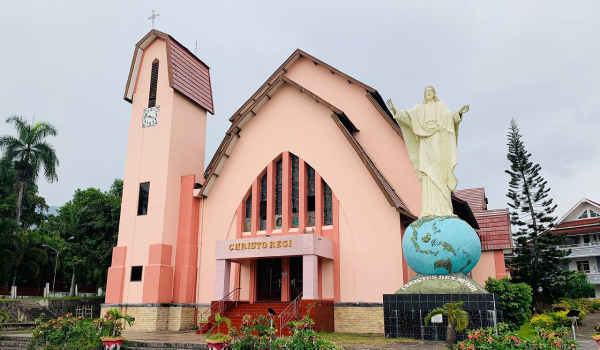
The archdiocese covers 5,084.50 square kilometers in the central part of Flores Island. It serves the people of Bajawa and Ende districts.
Ende is an archdiocese, with Atambua, Denpasar (Bali), Larantuka, Weetabula (Sumba) and Ruteng its suffragan dioceses. The first Archbishop of Ende was Monsignor Gabriel Manek, SVD, who had been the first Timorese to be ordained priest, in 1941.
Local people have their own traditions and languages, but they all speak the national language of Bahasa Indonesia.
The Archdiocese of Ende was established in 1961 as head of the ecclesiastical province that included the other five dioceses in East Nusa Tenggara and West Nusa Tenggara provinces. Based on Flores Island, it remained the regional Church center until the establishment of the Archdiocese of Kupang in 1967. The Church in the region, however, goes back to the 16th century, when Jesuits and Dominicans came with Portuguese traders who were looking for sandalwood in Timor Island. The Portuguese missioners operated within the rights granted them under the patronage arrangement approved by the Vatican and the kingdoms of Spain and Portugal.
Dominicans officially began the mission in 1561 on Solor Island, after obtaining an agreement from the bishop of Malacca. From their base on Solor, they visited Adonara Island and coastal areas of Flores. By the end of the 16th century, many local people had become Catholics, and 20 mission stations had been established on Solor, Adonara and Flores. In the early 17th century, however, local people supported by Muslims from Goa and Makassar as well as the Dutch opposed the Portuguese. Many missionaries were expelled or killed, and the faith life of Catholics in the area became weak.
The 1854 Lisbon Agreement between the Portuguese and the Dutch provided a favorable atmosphere for the renewal of mission work. This agreement was renewed and ratified in 1860, when Flores and Solor Islands were ceded to the Dutch. Dutch diocesan priests from the Apostolic Vicariate of Batavia (Jakarta), which covered all areas of the Dutch East Indies, gave the area increased attention from 1859. These priests were replaced by Jesuits, who began to work in Larantuka in 1863. In 1873, the Jesuits opened a new mission in Maumere. From these centers, mission work spread through the western part of Flores.
After the Society of the Divine Word requested a mission in the apostolic vicariate of Batavia, the Holy See in 1912 permitted the SVD to work in the Lesser Sunda Islands (Nusa Tenggara) under the jurisdiction of Batavia vicariate. At first, the society worked on Timor and Sunda Islands. In 1913, Father Petrus Noyen took up residence in Lahurus as coordinator of the mission on Timor Island, helped by several fellow Divine Word priests and brothers. In the same year, apostolic prefecture of Lesser Sunda was established and Father Noyen was appointed its apostolic prefect. In mid-1914, Flores was brought into in the prefecture, and the Jesuits left in 1920.
Following his visit to Flores, Father Noyen felt that Ende (Ndona) was the most suitable base for the prefecture. During 1915/1916, he built a residence there as well as a school. The prefecture covered all of Nusa Tenggara: Bali, Lombok, Sumbawa, Sumba, Flores, Solor, Adonara, Lembata, Pantar, Alor, Timor and the many smaller islands.
The mission grew quickly, and was elevated in 1922 to the apostolic vicariate of Lesser Sunda, led by Monsignor Arnold Vestralen, SVD. When Monsignor Vestralen died due to a car accident in 1932, Monsignor Hendrikus Leven, SVD, succeeded him and led the vicariate until 1951. The local Church continued to develop rapidly, even amid war and Indonesians' struggle to free themselves from Dutch and Japanese colonization. Many churches and chapels were built for the sake of sacramental ministry,while many schools were established to educate children. In 1926, a seminary was established in Sikka, but it was later moved to Mataloko. In 1937, the Society of the Divine Word opened a major seminary in Ledalero, Maumere. Four years later, the first local vocations were ordained priests. Meanwhile, the local women's congregation of the Followers of Jesus was established in 1935.
Due to the increase in the number of Catholics, however, pastoral work became increasingly difficult for one apostolic vicar to manage alone. So the Holy See created the apostolic vicariate of West Timor in 1936. In 1950, two prefectures were created from the remaining Lesser Sunda territory: the apostolic prefecture of Sumba and the apostolic prefecture of Bali-Lombok. Even so, the prosperous mission on Flores required further divisions, and in 1951 the Church there was divided into three more vicariates: the apostolic vicariate of Ende, led by Monsignor Antonius Thijssen, SVD; the apostolic vicariate of Larantuka, led by Monsignor Gabriel Manek, SVD; and the apostolic vicariate of Ruteng, led by Monsignor Wilhelmus van Bekkum, SVD. Ende vicariate covered Ngada, Ende and Sikka districts.
Many people earn their living as subsistence farmers. Only a few work as fishermen, animal breeders, laborers or at other jobs.In general, they are not rich economically.